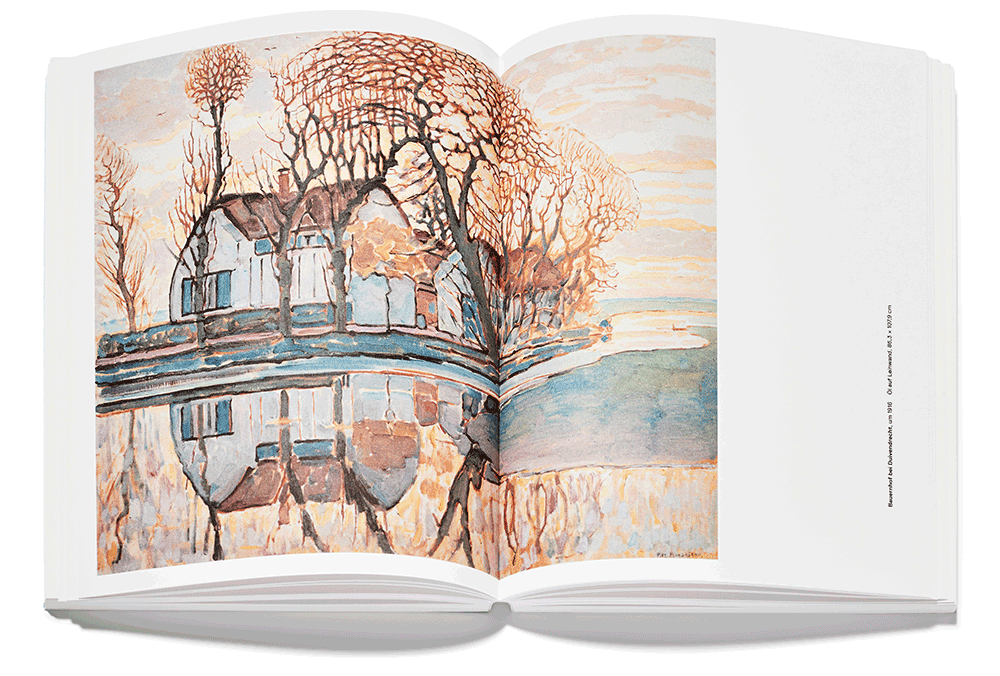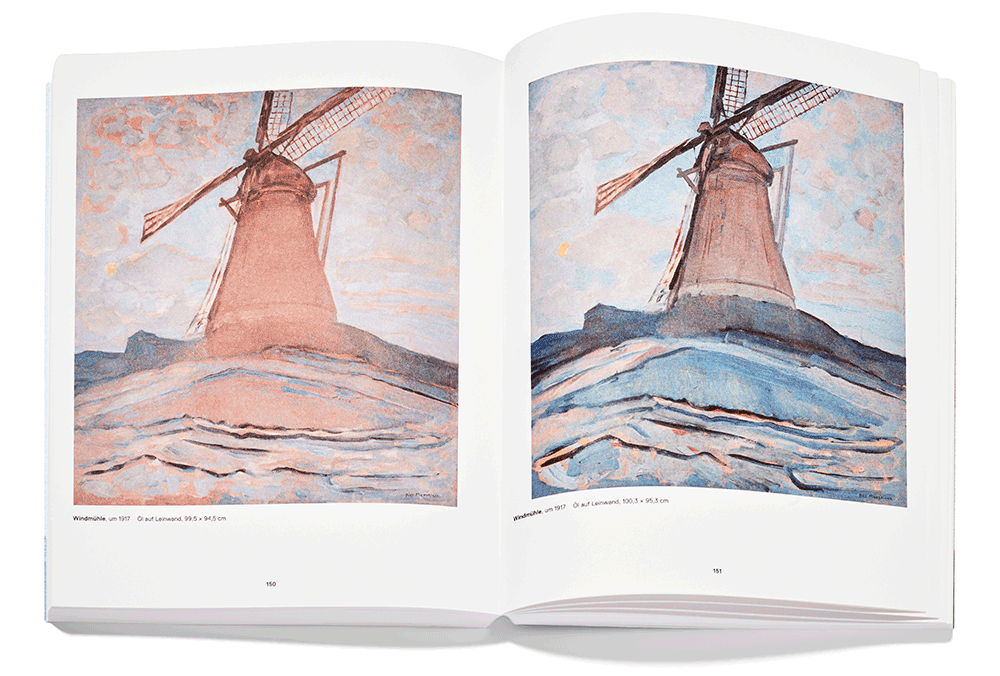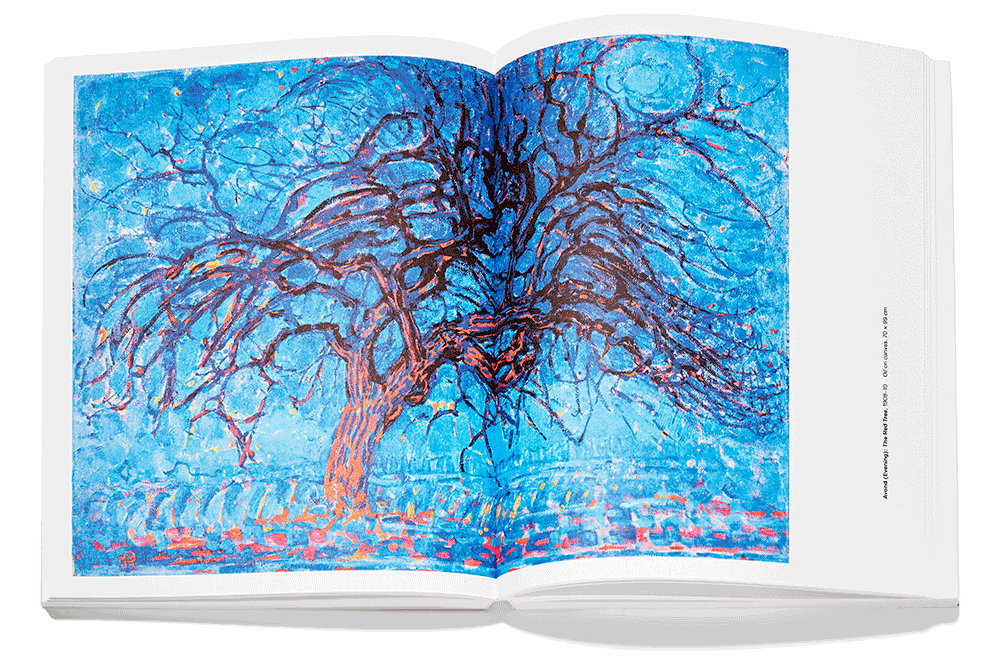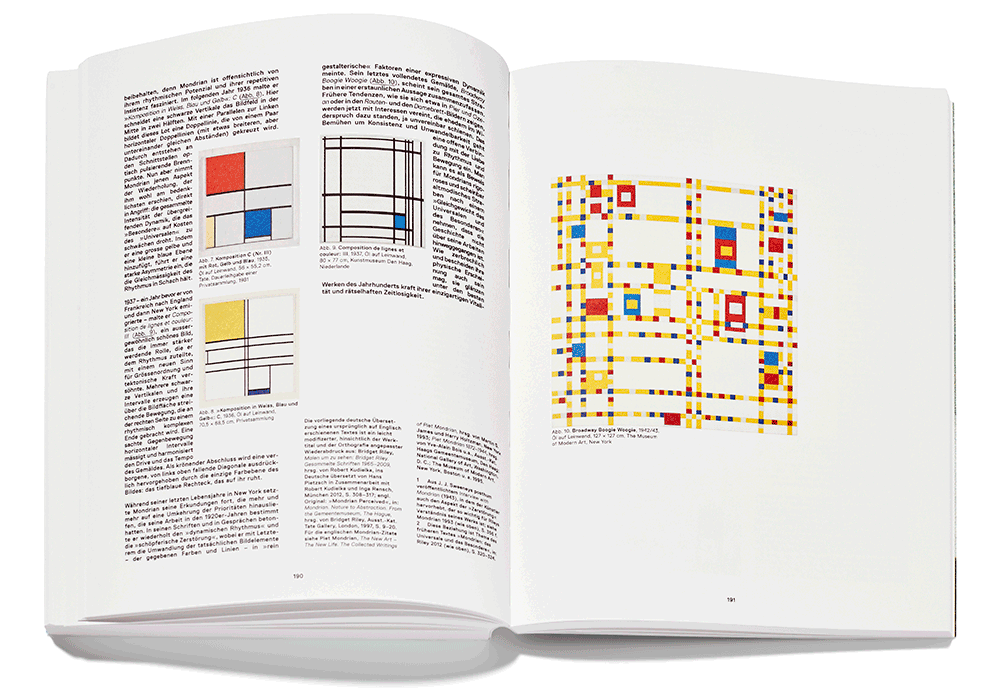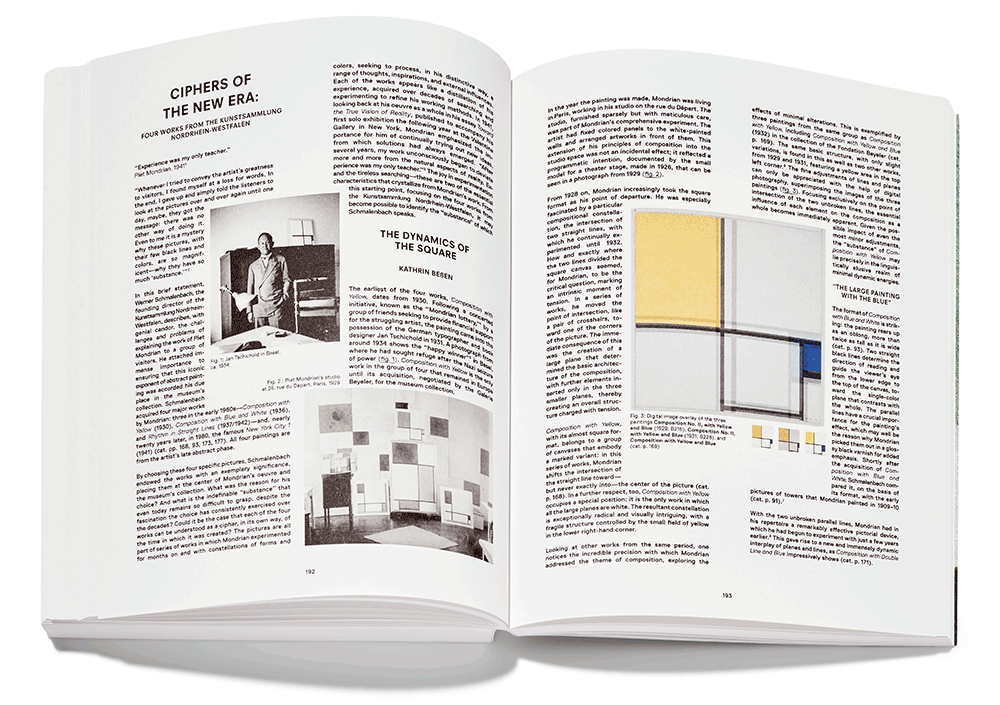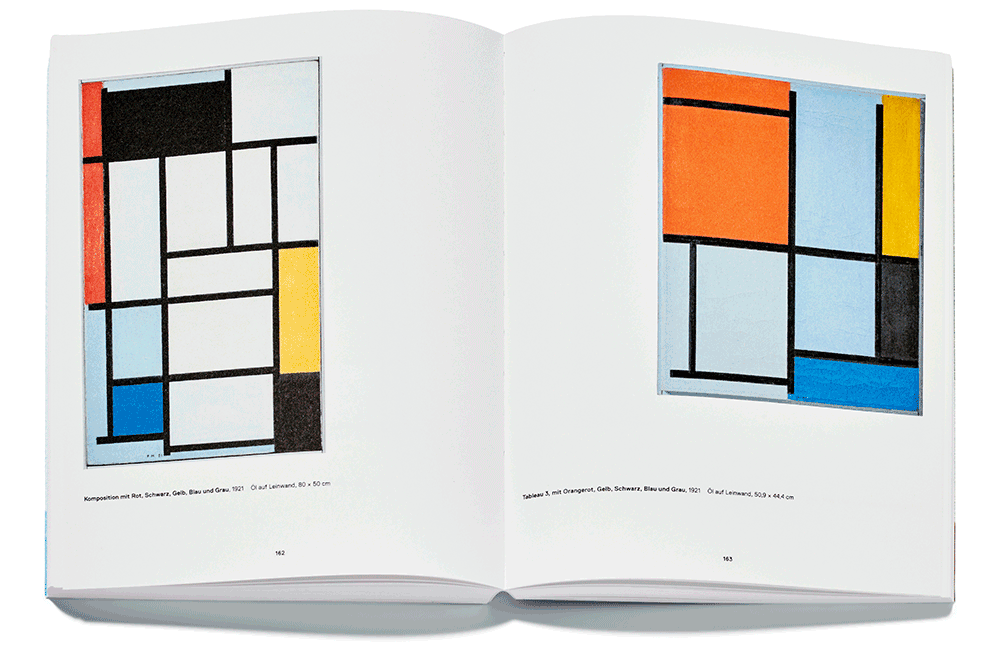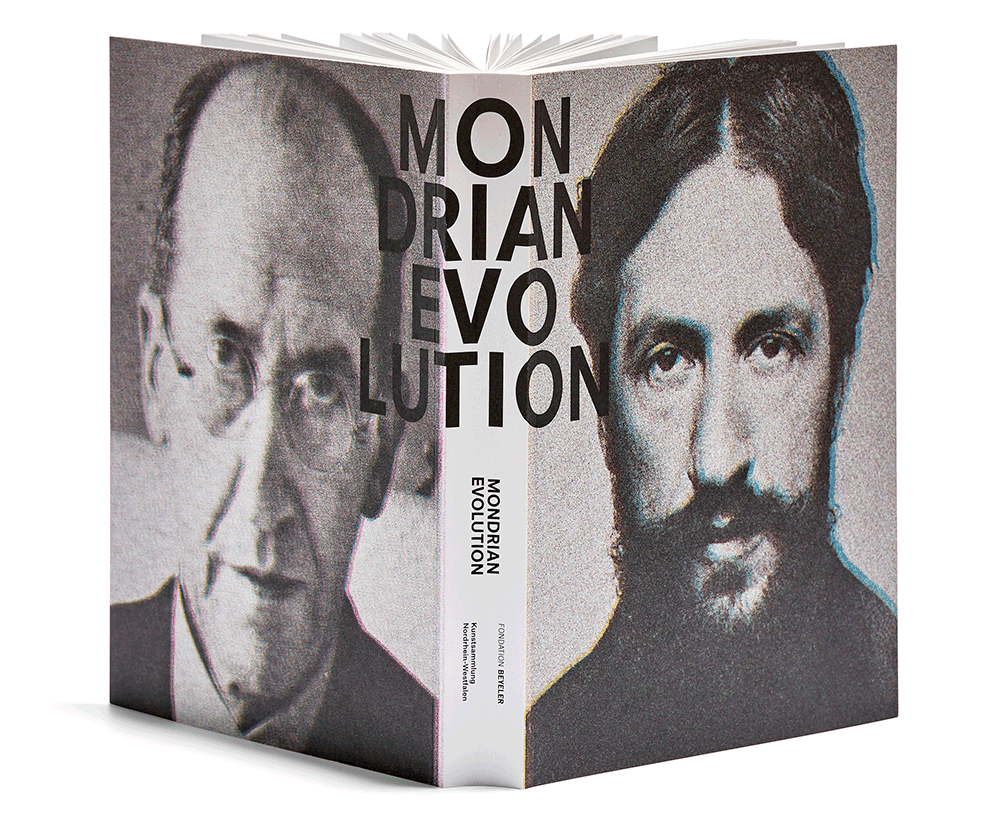MONDRIAN EVOLUTION
at the Fondation Beyeler
5 June – 9 October 2022
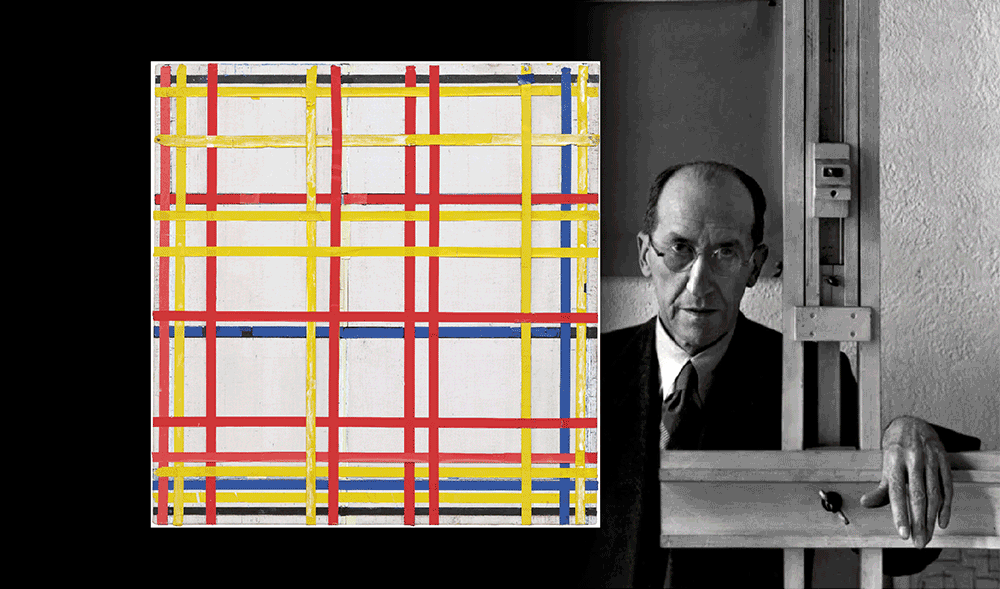 Piet Mondrian in his New York Studio, 1942, portrayed by Arnold Newman.
Piet Mondrian in his New York Studio, 1942, portrayed by Arnold Newman.
Painting title: New York City 1, 1941. Oil and paper on canvas, 120 × 115.2 cm,
Kunstsammlung Nordrhein-Westfalen, Düsseldorf
A successful road from Figuration to Abstraction
Bringing together works from its own collection and major international loans, the Fondation Beyeler dedicates an anthological exhibition that explains the evolution of the pictorial work of the Dutch artist Piet Mondrian (1872-1944)
The exhibition extensively presents the Mondrian’s early works, initially influenced by late 19th century painting, then shows how symbolism and cubism also played an important role in his artistic development, and finally his abstract work that has significantly influenced 20th century art in painting, design, architecture, fashion and pop culture.
The beginnings
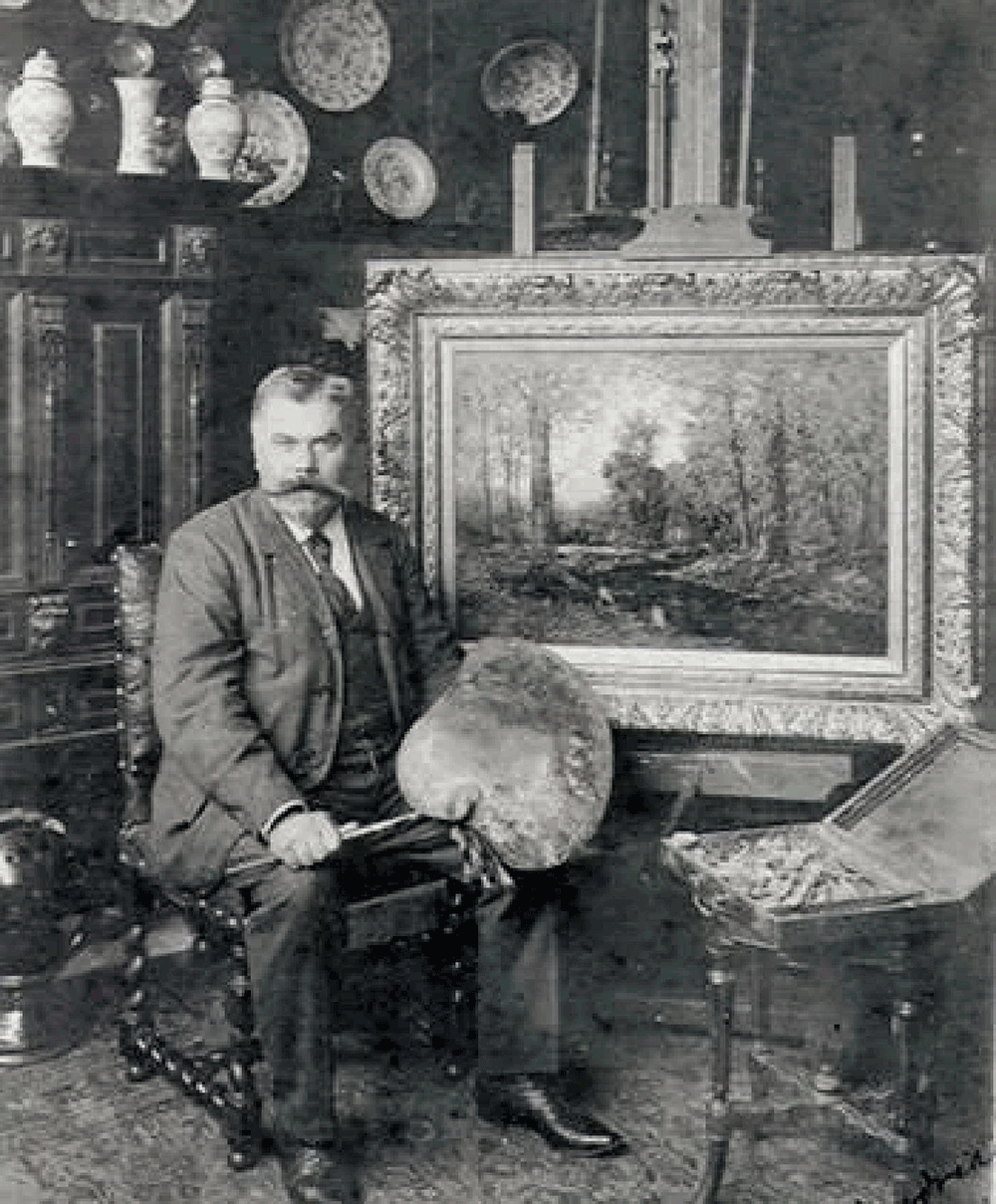 Mondrian was born in 1872 in Amersfoort (The Netherlands).
Mondrian was born in 1872 in Amersfoort (The Netherlands).
At a very young age he came into contact with art because his father was a drawing teacher and his uncle Fritz Mondriaan was an amateur painter influenced by the Hague School whose works were very successful.
Fritz Mondriaan in his studio
with a landscape painting
in the characteristic style
of The Hague School
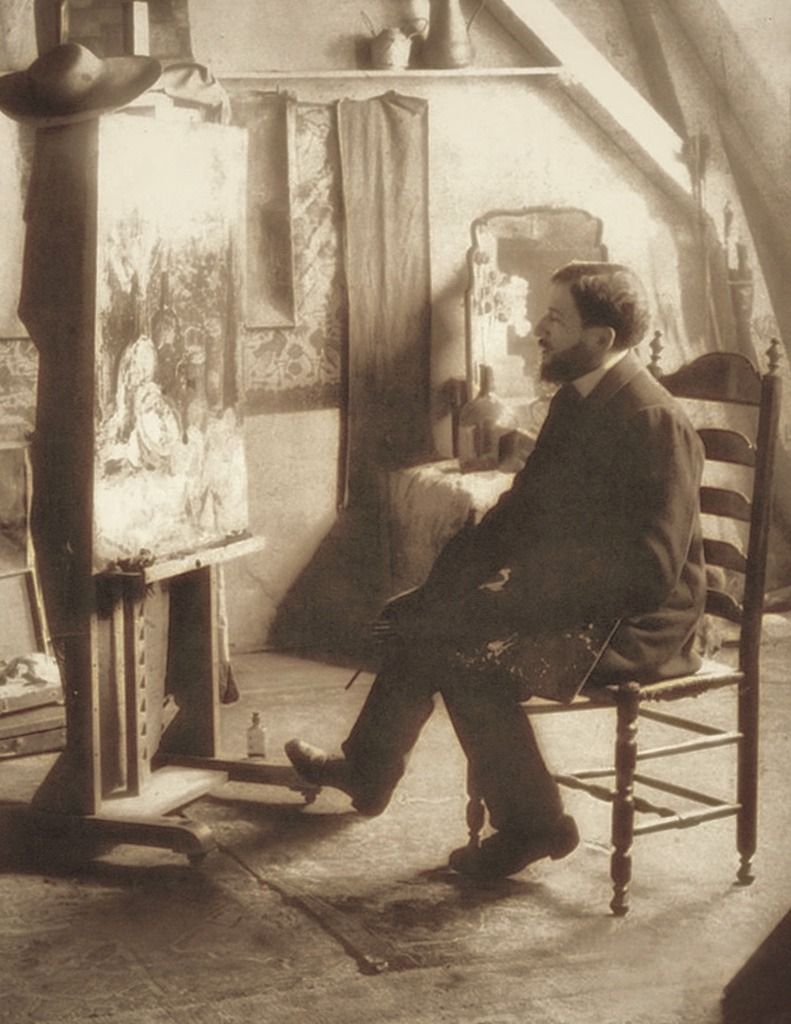 Mondrian receives his first drawing lessons from his father and his uncle Frits Mondriaan. In 1886, after completing his school studies, he decides to pursue a career as an artist. In 1892 he becomes qualified to teach drawing at secondary schools. Mondrian enrolls to study painting at the Rijksakademie van Beeldende Kunsten in Amsterdam, where he receives a classical training. He completes his studies in 1895 and begins to work as a copyist, drawing teacher and undertakes portrait commissions and produced scientific drawings for Leiden University.
Mondrian receives his first drawing lessons from his father and his uncle Frits Mondriaan. In 1886, after completing his school studies, he decides to pursue a career as an artist. In 1892 he becomes qualified to teach drawing at secondary schools. Mondrian enrolls to study painting at the Rijksakademie van Beeldende Kunsten in Amsterdam, where he receives a classical training. He completes his studies in 1895 and begins to work as a copyist, drawing teacher and undertakes portrait commissions and produced scientific drawings for Leiden University.
Until 1907 Mondrian mainly paints landscapes in the naturalist style of The Hague School.
Mondrian in his
Amsterdam studio
Making Mondrian’s evolution evident
by confronting his works
The museography proposal understands chronology in a singular way. Early and more advanced works are presented together. So the evolution is not only evident but also more impressive.
Installation view “Mondrian Evolution” at the Fondation Beyeler, Riehen/Basel, 2022
© 2022 Mondrian/Holtzman Trust. Photo: Mark Niedermann:
left, New York 1, 1941 right, Woods near Oele, 1908
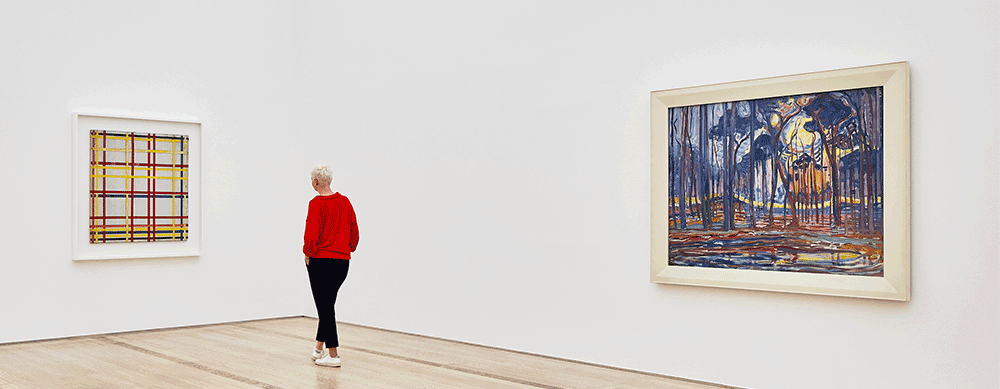
1907: Beginnings of change
Under the influence of both Toorop and Vincent van Gogh, and following his study of Johann Wolfgang von Goethe’s color theory, Mondrian turns away from the Hague School. His palette becomes lighter and more expressive, and his painting style becomes spontaneous and sketchy.
The Red Cloud
A pictorial abstraction with which Mondrian tries to express the magnificent
and brief moment when the low sun turns a cloud into a luminous red while
the landscape and the sky continue to appear radiant blue
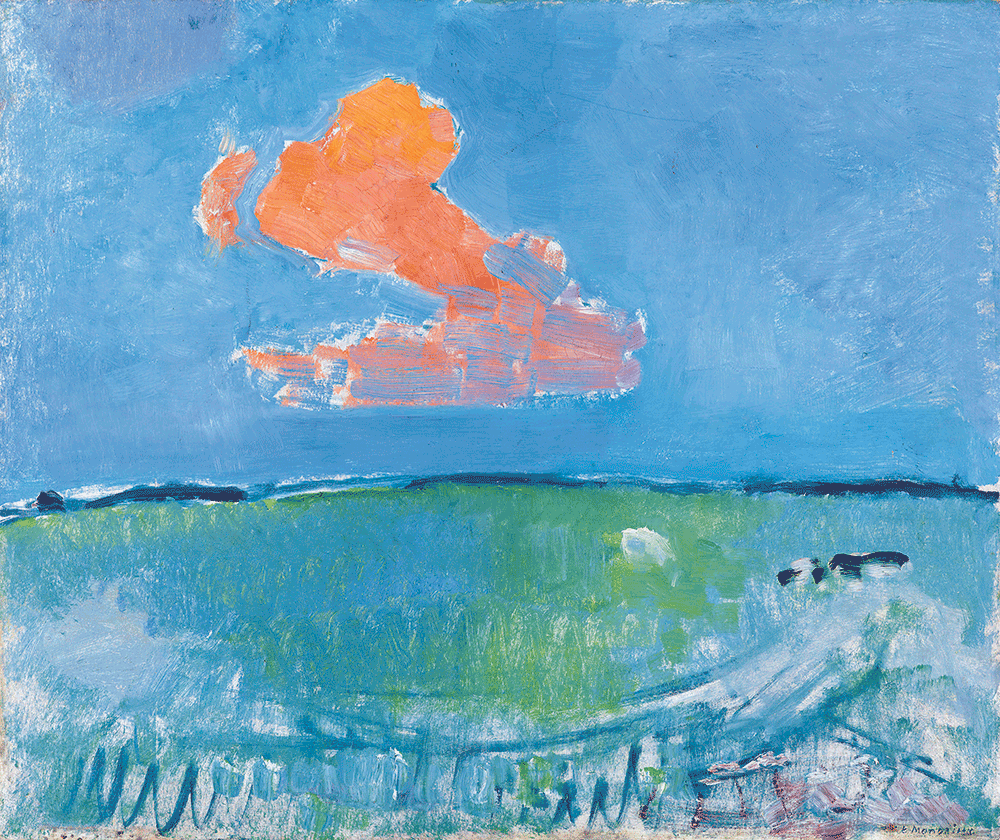 Piet Mondrian. The Red Cloud, 1907, Oil on cardboard, 64 x 75 cm. Kunstmuseum Den Haag, The Hague, The Netherlands © 2022 Mondrian/Holtzman Trust.Photo: Kunstmuseum Den Haag
Piet Mondrian. The Red Cloud, 1907, Oil on cardboard, 64 x 75 cm. Kunstmuseum Den Haag, The Hague, The Netherlands © 2022 Mondrian/Holtzman Trust.Photo: Kunstmuseum Den Haag
Church Tower at Domburg
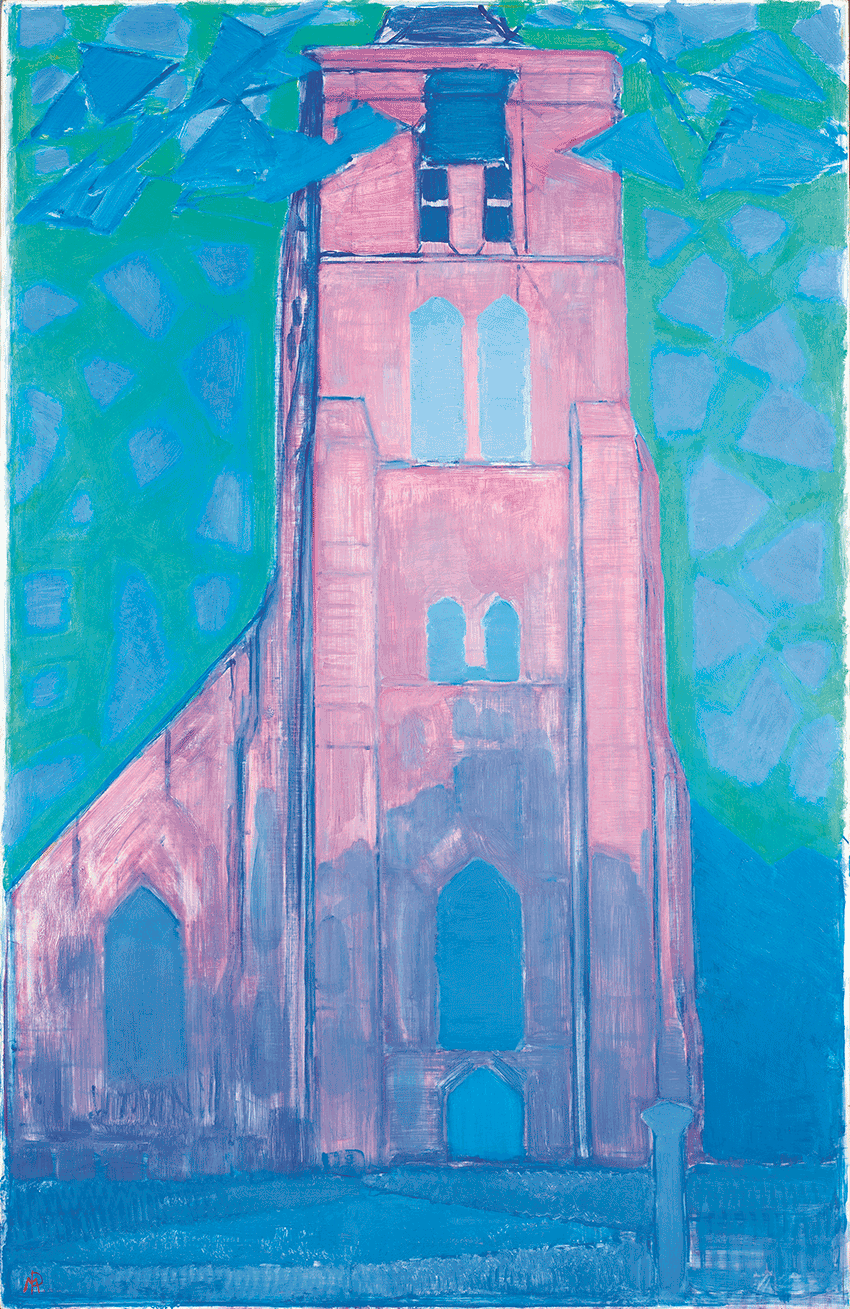 Piet Mondrian. Church Tower at Domburg, 1911, Oil on canvas, 114 × 75 cm. Kunstmuseum Den Haag, The Hague, The Netherlands, bequest Salomon B. Slijper © 2022 Mondrian/Holtzman Trust. Photo: Kunstmuseum Den Haag
Piet Mondrian. Church Tower at Domburg, 1911, Oil on canvas, 114 × 75 cm. Kunstmuseum Den Haag, The Hague, The Netherlands, bequest Salomon B. Slijper © 2022 Mondrian/Holtzman Trust. Photo: Kunstmuseum Den Haag
Oostzijdse Mill in the Evening
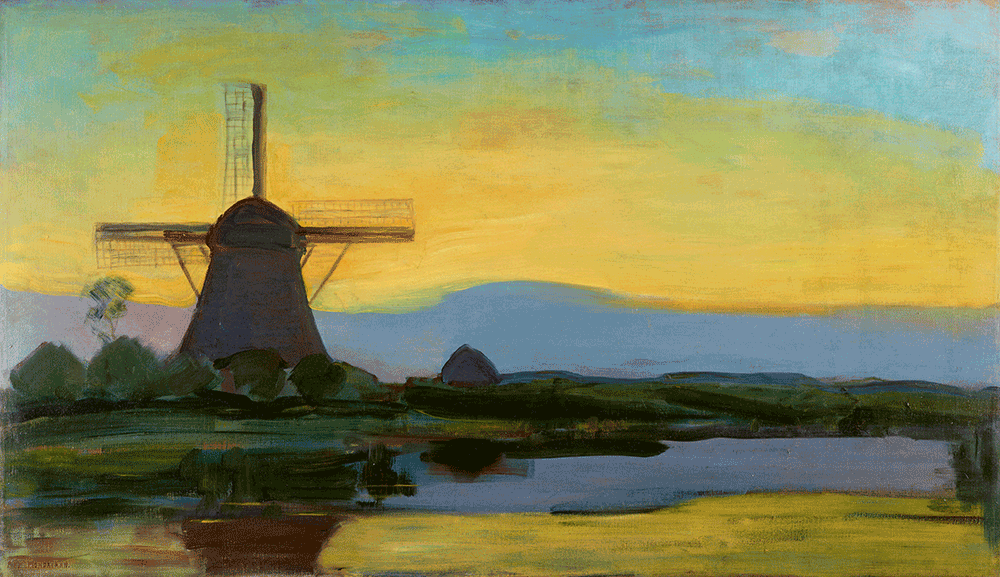 Piet Mondrian. Oostzijdse Mill in the Evening, ca. 1907–1908, Oil on canvas, 67.5 × 117.5 cm. Kunstmuseum Den Haag, The Hague, The Netherlands, bequest Salomon B. Slijper © 2022 Mondrian/Holtzman Trust. Photo: Kunstmuseum Den Haag
Piet Mondrian. Oostzijdse Mill in the Evening, ca. 1907–1908, Oil on canvas, 67.5 × 117.5 cm. Kunstmuseum Den Haag, The Hague, The Netherlands, bequest Salomon B. Slijper © 2022 Mondrian/Holtzman Trust. Photo: Kunstmuseum Den Haag
Mill in Sunlight
Painted in 1908, it caused a stir among contemporary critics
for its bold use of color and sketchy pictorial technique
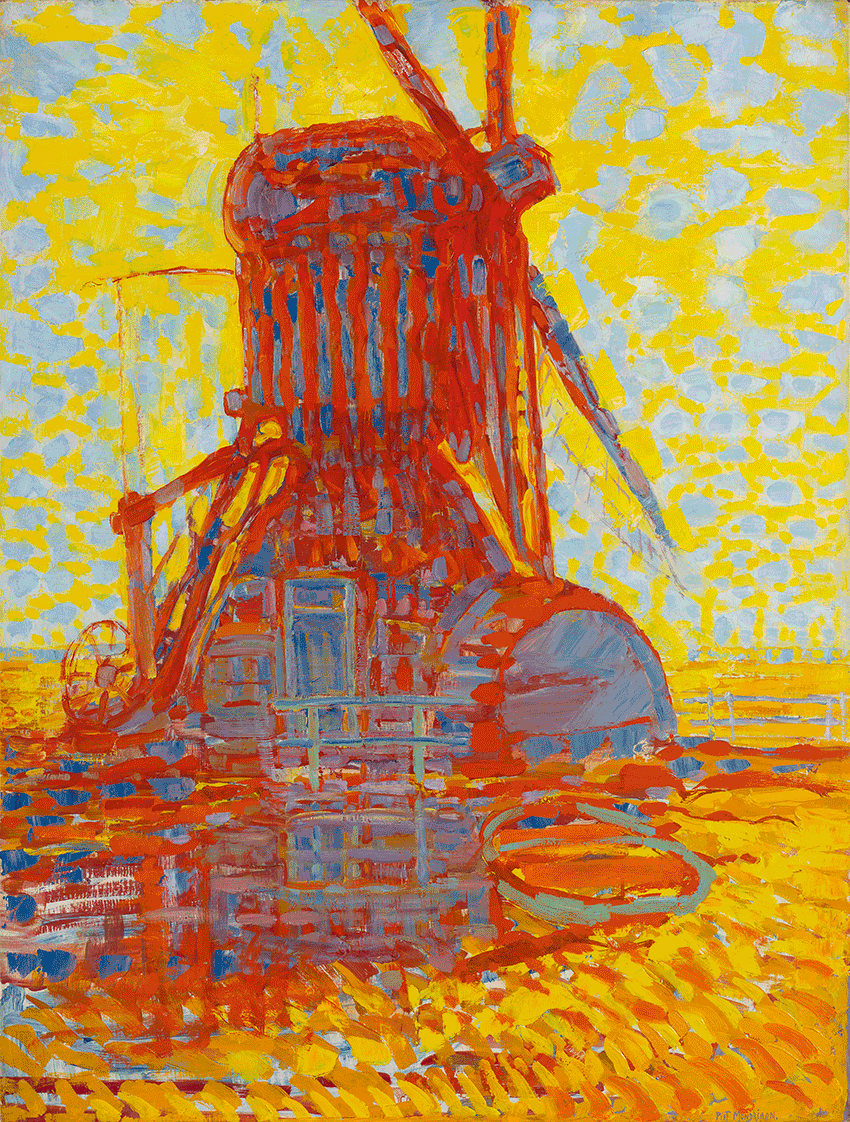 Piet Mondrian. Mill in Sunlight, 1908,Oil on canvas, 114.8 x 87 cm. Kunstmuseum Den Haag, The Hague, The Netherlands, bequest Salomon B. Slijper; This painting has been restored with financial support from American Express © 2022 Mondrian/Holtzman Trust. Photo: Kunstmuseum Den Haag
Piet Mondrian. Mill in Sunlight, 1908,Oil on canvas, 114.8 x 87 cm. Kunstmuseum Den Haag, The Hague, The Netherlands, bequest Salomon B. Slijper; This painting has been restored with financial support from American Express © 2022 Mondrian/Holtzman Trust. Photo: Kunstmuseum Den Haag
Windmill in the Evening
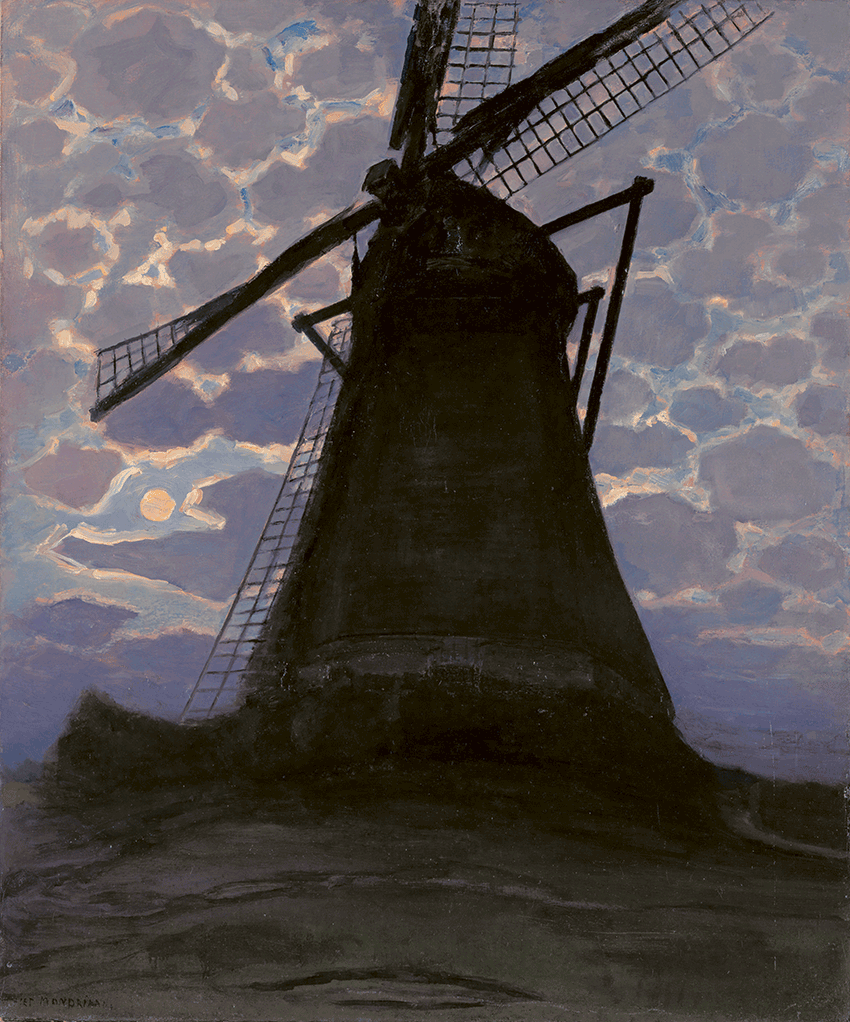 Piet Mondrian. Windmill in the Evening, 1917, Oil on canvas, 103 × 86 cm. Kunstmuseum Den Haag, The Hague, The Netherlands, bequest Salomon B. Slijper © 2022 Mondrian/Holtzman Trust
Piet Mondrian. Windmill in the Evening, 1917, Oil on canvas, 103 × 86 cm. Kunstmuseum Den Haag, The Hague, The Netherlands, bequest Salomon B. Slijper © 2022 Mondrian/Holtzman Trust
Photo: Kunstmuseum Den Haag.
Woods near Oele
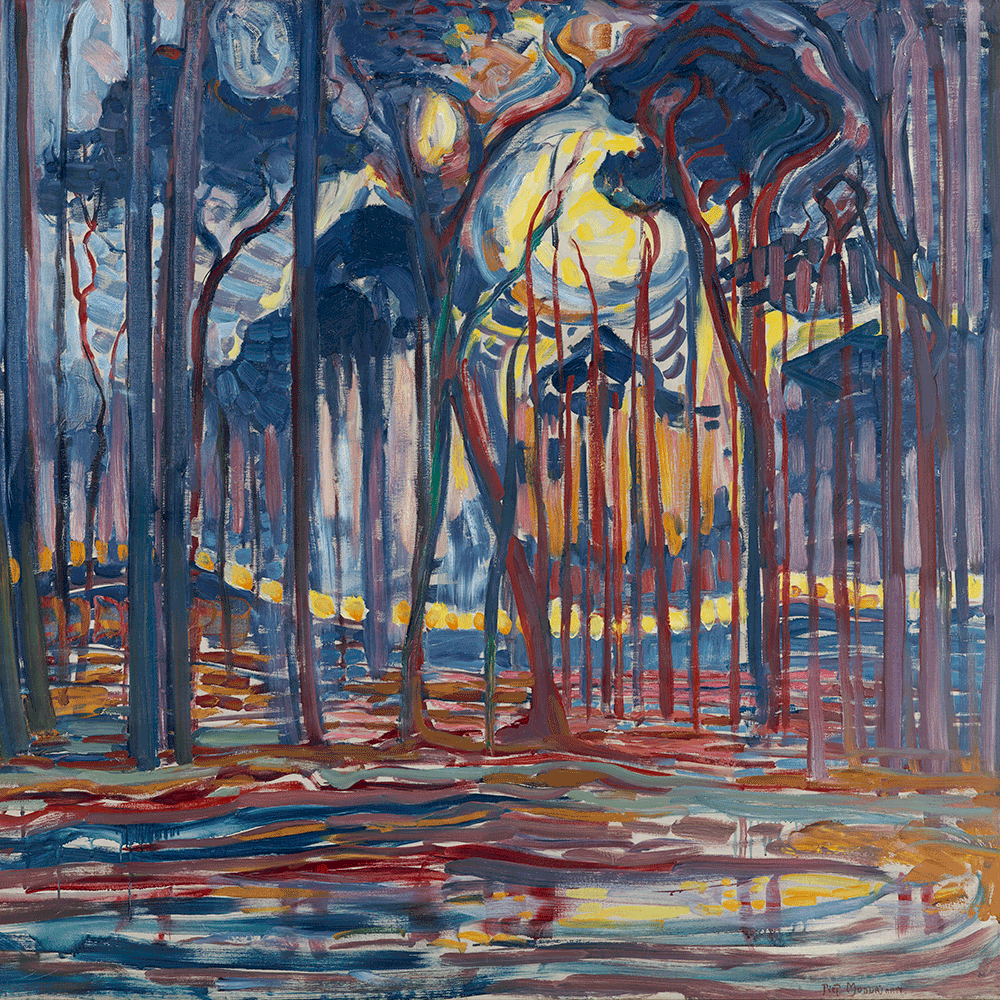 Piet Mondrian. Woods near Oele, 1908, Oil on canvas, 128 × 158 cm. Kunstmuseum Den Haag, The Hague, The Netherlands, bequest Salomon B. Slijper © 2022 Mondrian/Holtzman Trus. Photo: Kunstmuseum Den Haag.
Piet Mondrian. Woods near Oele, 1908, Oil on canvas, 128 × 158 cm. Kunstmuseum Den Haag, The Hague, The Netherlands, bequest Salomon B. Slijper © 2022 Mondrian/Holtzman Trus. Photo: Kunstmuseum Den Haag.
Farm near Duivendrecht
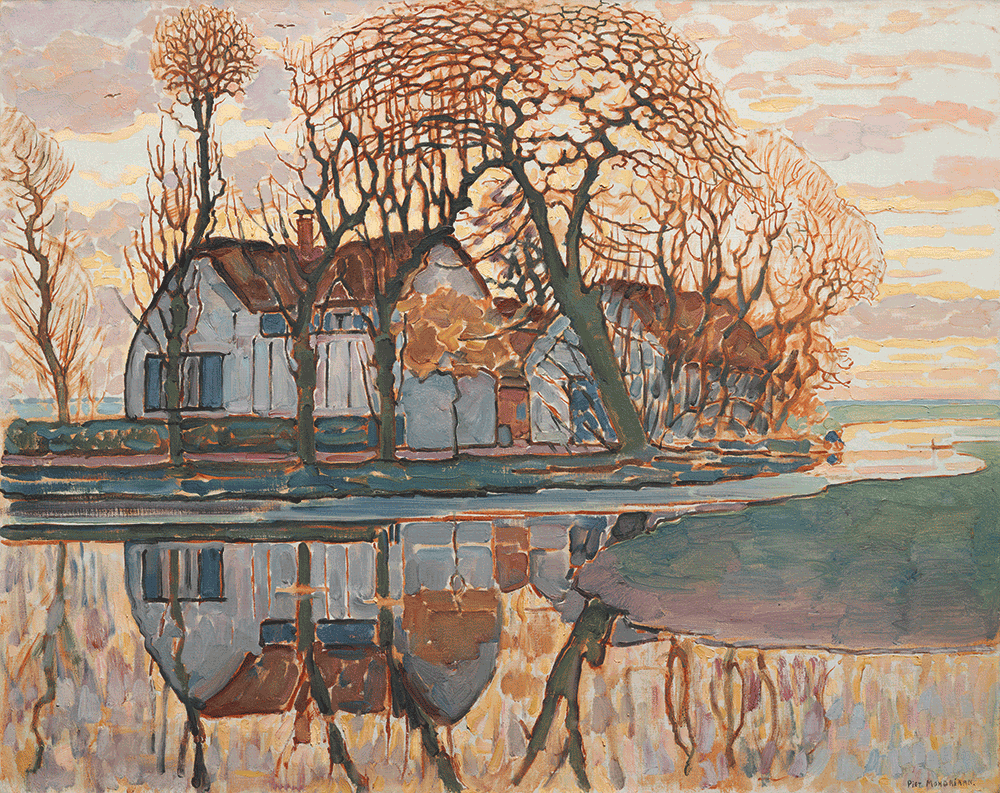 Piet Mondrian. Farm near Duivendrecht, ca. 1916, Oil on canvas, 86.3 x 107.9 cm. The Art Institute of Chicago, gift of Dolly J. van der Hoop Schoenberg © 2022 Mondrian/Holtzman Trust. Photo: bpk/The Art Institute of Chicago/Art Resource, NY
Piet Mondrian. Farm near Duivendrecht, ca. 1916, Oil on canvas, 86.3 x 107.9 cm. The Art Institute of Chicago, gift of Dolly J. van der Hoop Schoenberg © 2022 Mondrian/Holtzman Trust. Photo: bpk/The Art Institute of Chicago/Art Resource, NY
APPROACHING
CUBISM
Particularly striking are his representations of trees
in metamorphosis in search of abstraction,
which allow us to trace the reasoning behind his artistic quest.
These experiences allowed Mondrian to leave figuration behind.
Evening: The Red Tree
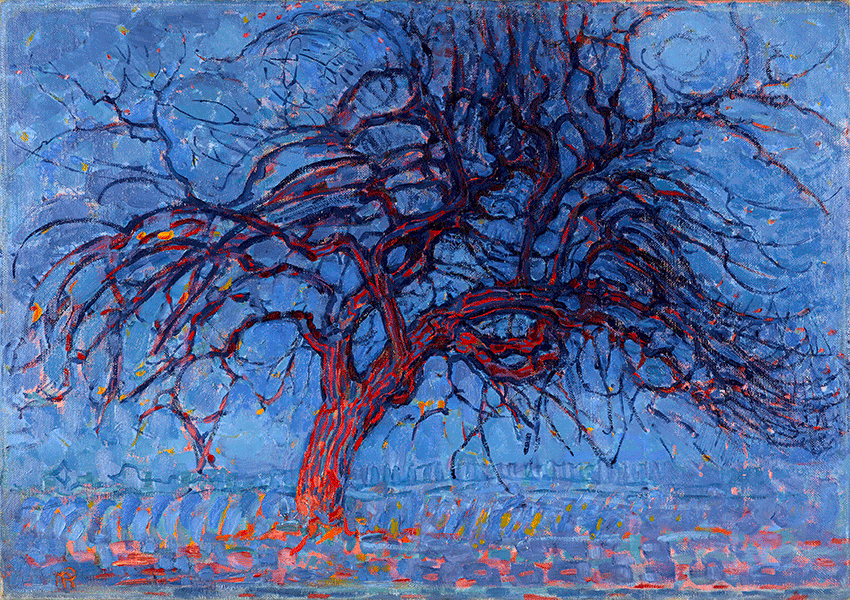 Piet Mondrian. Evening: The Red Tree, 1908– 1910, Oil on canvas, 70 x 99 cm. Kunstmuseum Den Haag, The Hague, The Netherlands © 2022 Mondrian/Holtzman Trust. Photo: Kunstmuseum Den Haag
Piet Mondrian. Evening: The Red Tree, 1908– 1910, Oil on canvas, 70 x 99 cm. Kunstmuseum Den Haag, The Hague, The Netherlands © 2022 Mondrian/Holtzman Trust. Photo: Kunstmuseum Den Haag
Flowering Apple Tree
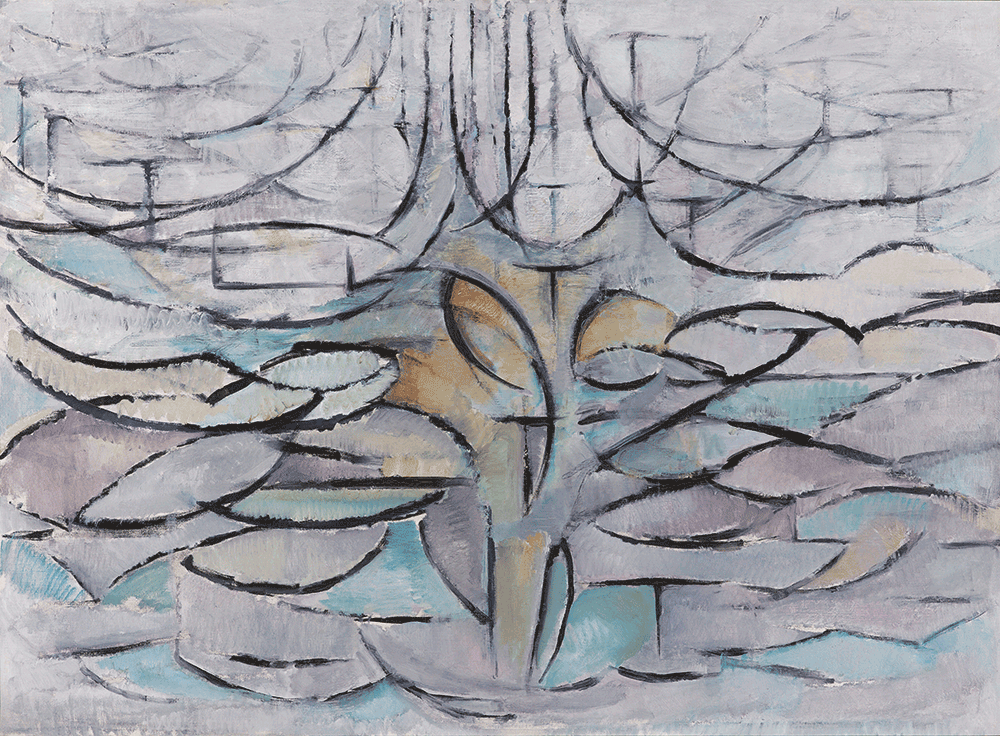 Piet Mondrian. Flowering Apple Tree, 1912, Oil on canvas, 78.5 × 107.5 cm. Kunstmuseum Den Haag, The Hague, The Netherlands © 2022 Mondrian/Holtzman Trust. Photo: Kunstmuseum Den Haag
Piet Mondrian. Flowering Apple Tree, 1912, Oil on canvas, 78.5 × 107.5 cm. Kunstmuseum Den Haag, The Hague, The Netherlands © 2022 Mondrian/Holtzman Trust. Photo: Kunstmuseum Den Haag
Tree
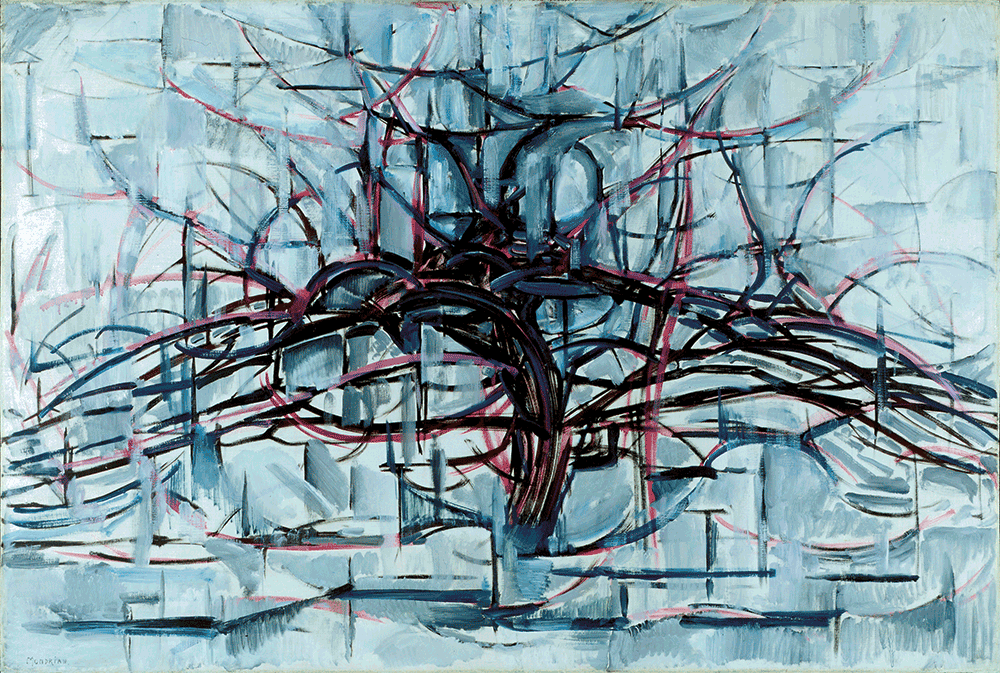 Piet Mondrian. Tree, 1912 (?) Oil on canvas, 74.9 × 111.8 cm. Munson Williams Proctor Arts Institute, Museum of Art, Utica, NY © 2022 Mondrian/Holtzman Trust. Photo: bpk/Munson-Williams-Proctor Arts Institute/Art Resource, NY
Piet Mondrian. Tree, 1912 (?) Oil on canvas, 74.9 × 111.8 cm. Munson Williams Proctor Arts Institute, Museum of Art, Utica, NY © 2022 Mondrian/Holtzman Trust. Photo: bpk/Munson-Williams-Proctor Arts Institute/Art Resource, NY
Eukalyptus
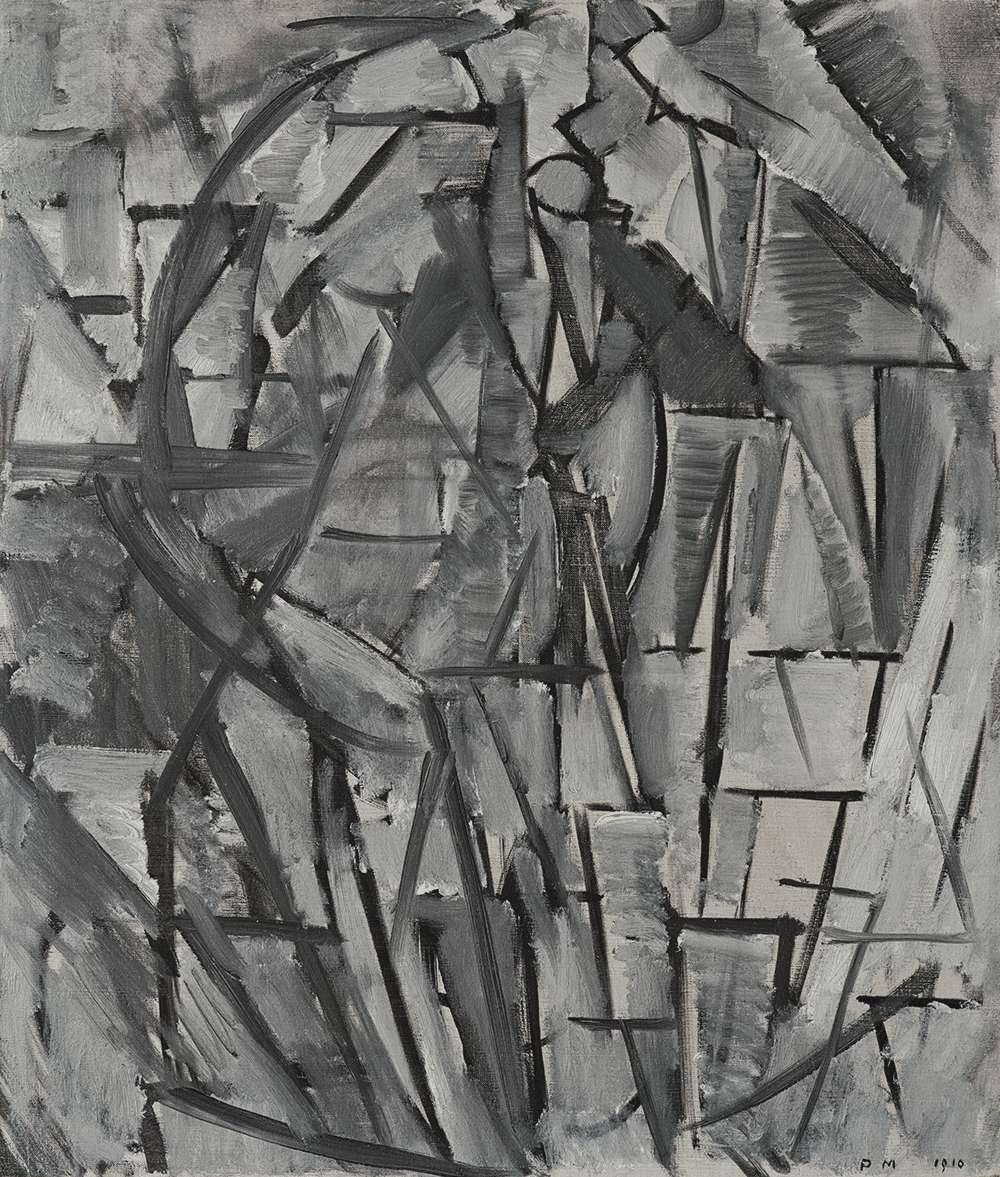
Piet Mondrian. Eukalyptus, 1912. Oil on canvas, 60,0 x 51,0 cm. Fondation Beyeler, Riehen / Basel, Beyeler Collection © Mondrian / Holtzman Trust c/o HCR International Warrenton, VA USA.
Photo: Robert Bayer, Basel
Mondrian in Paris
Mondrian’s studio in Paris at 26 Rue de Départ. He rented it in 1912 and used it during various stages of his life. In this photo you can see works from his cubism period.
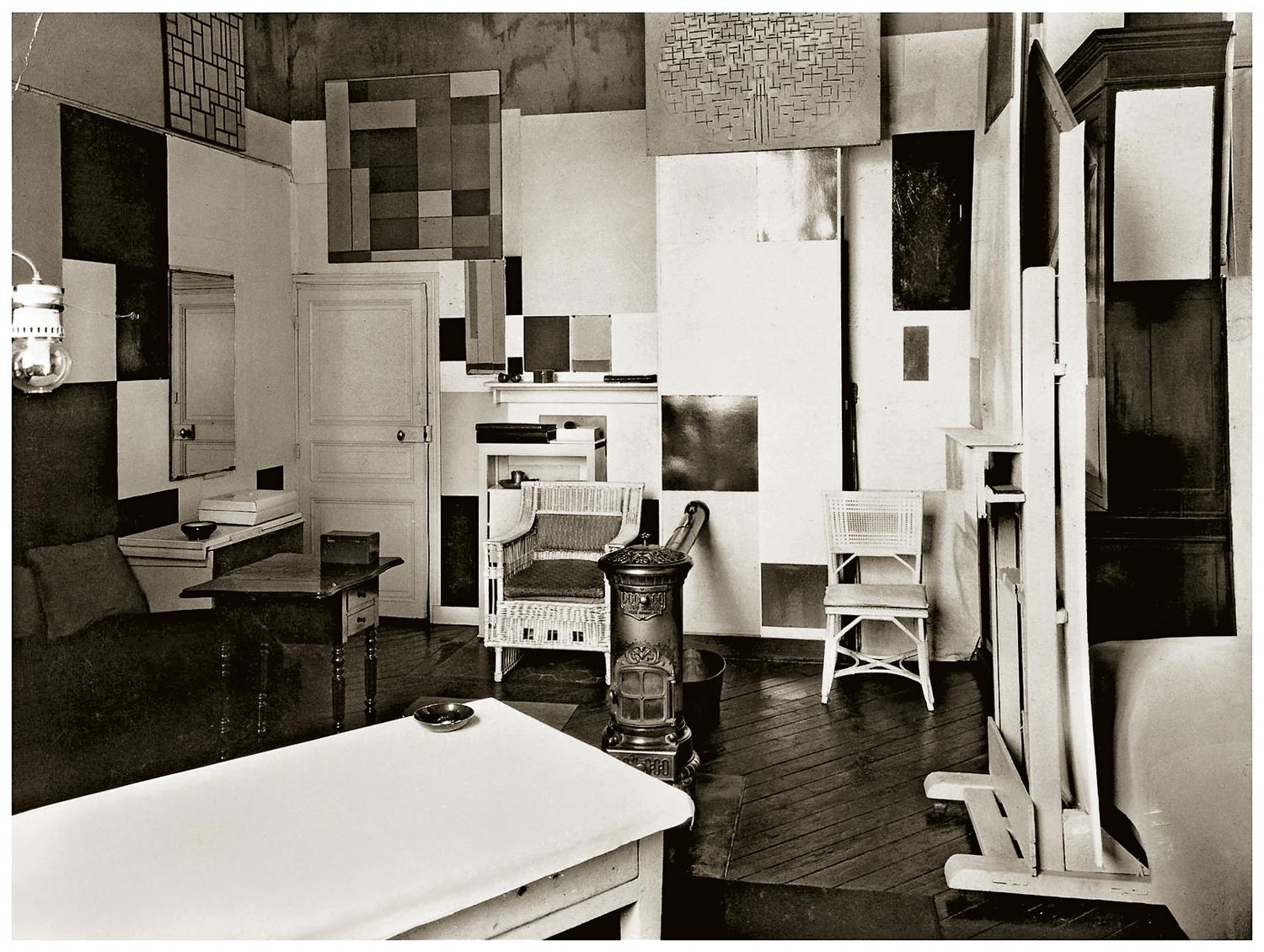
Composition No. XVI (Compositie I, Arbres)
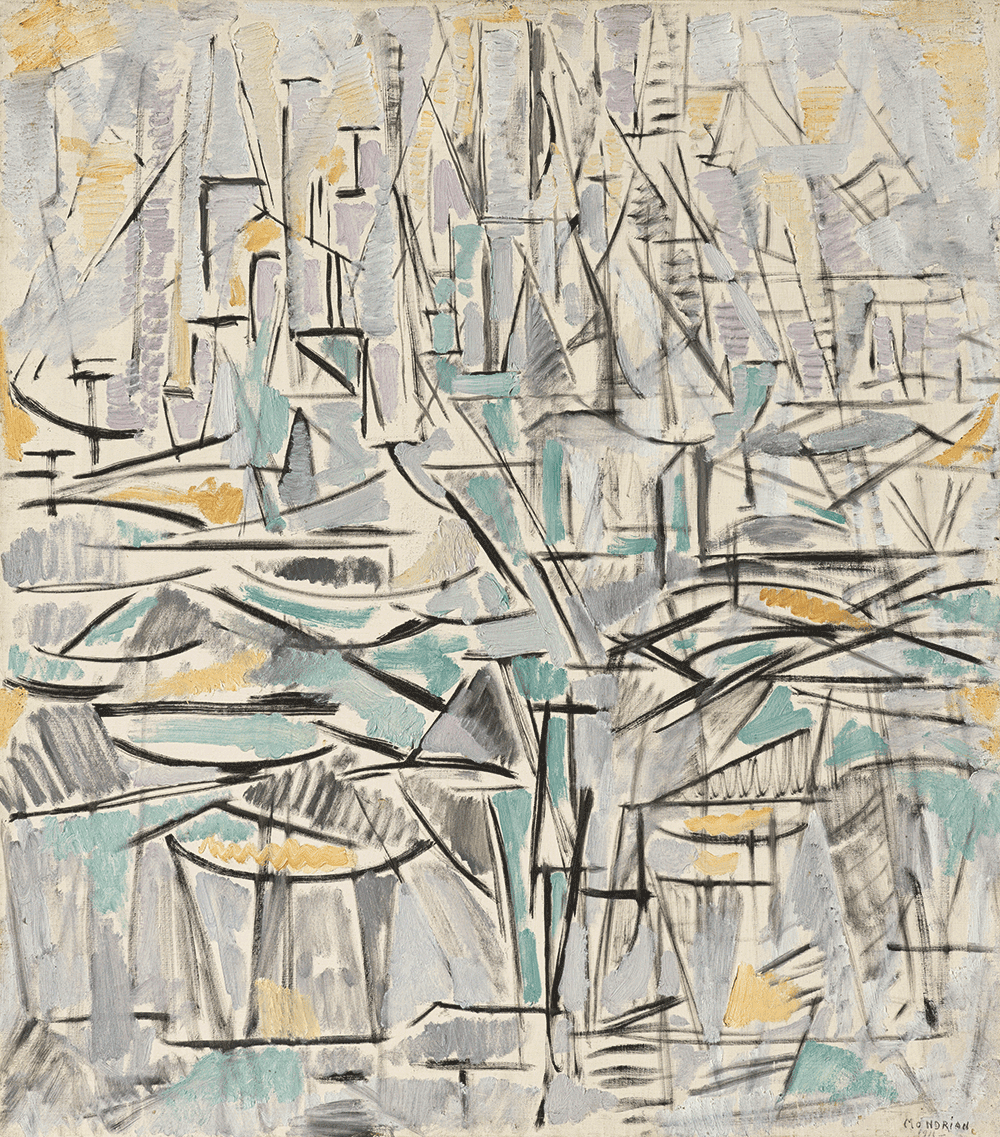 Piet Mondrian. Composition No. XVI (Compositie I, Arbres), 1912–1913, Oil on canvas, 85,5 x 75,0 cm. Fondation Beyeler, Riehen / Basel, Beyeler Collection © Mondrian / Holtzman Trust c/o HCR International Warrenton, VA USA. Photo: Robert Bayer, Basel
Piet Mondrian. Composition No. XVI (Compositie I, Arbres), 1912–1913, Oil on canvas, 85,5 x 75,0 cm. Fondation Beyeler, Riehen / Basel, Beyeler Collection © Mondrian / Holtzman Trust c/o HCR International Warrenton, VA USA. Photo: Robert Bayer, Basel
Composition No. II
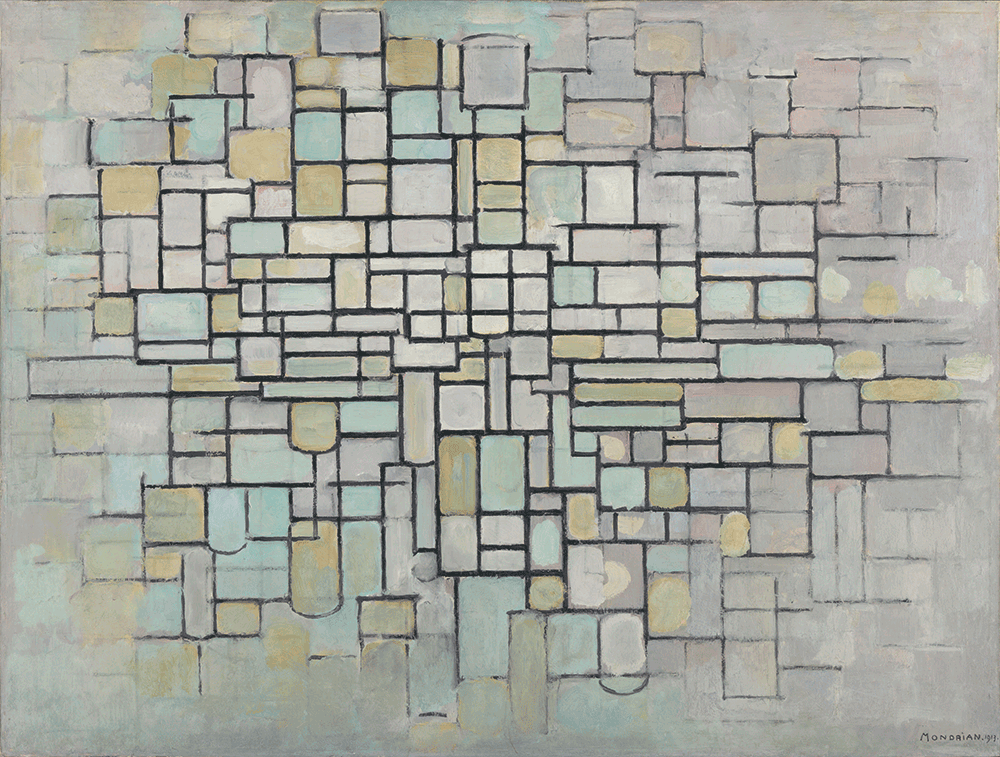 Piet Mondrian. Composition No. II, 1913, Oil on canvas, 88 × 115 cm. Kröller-Müller Museum, Otterlo, The Netherlands © 2022 Mondrian/Holtzman Trust. Photo: Rik Klein Gotnik
Piet Mondrian. Composition No. II, 1913, Oil on canvas, 88 × 115 cm. Kröller-Müller Museum, Otterlo, The Netherlands © 2022 Mondrian/Holtzman Trust. Photo: Rik Klein Gotnik
Composition No. VI (Composition 9, Blue Façade)
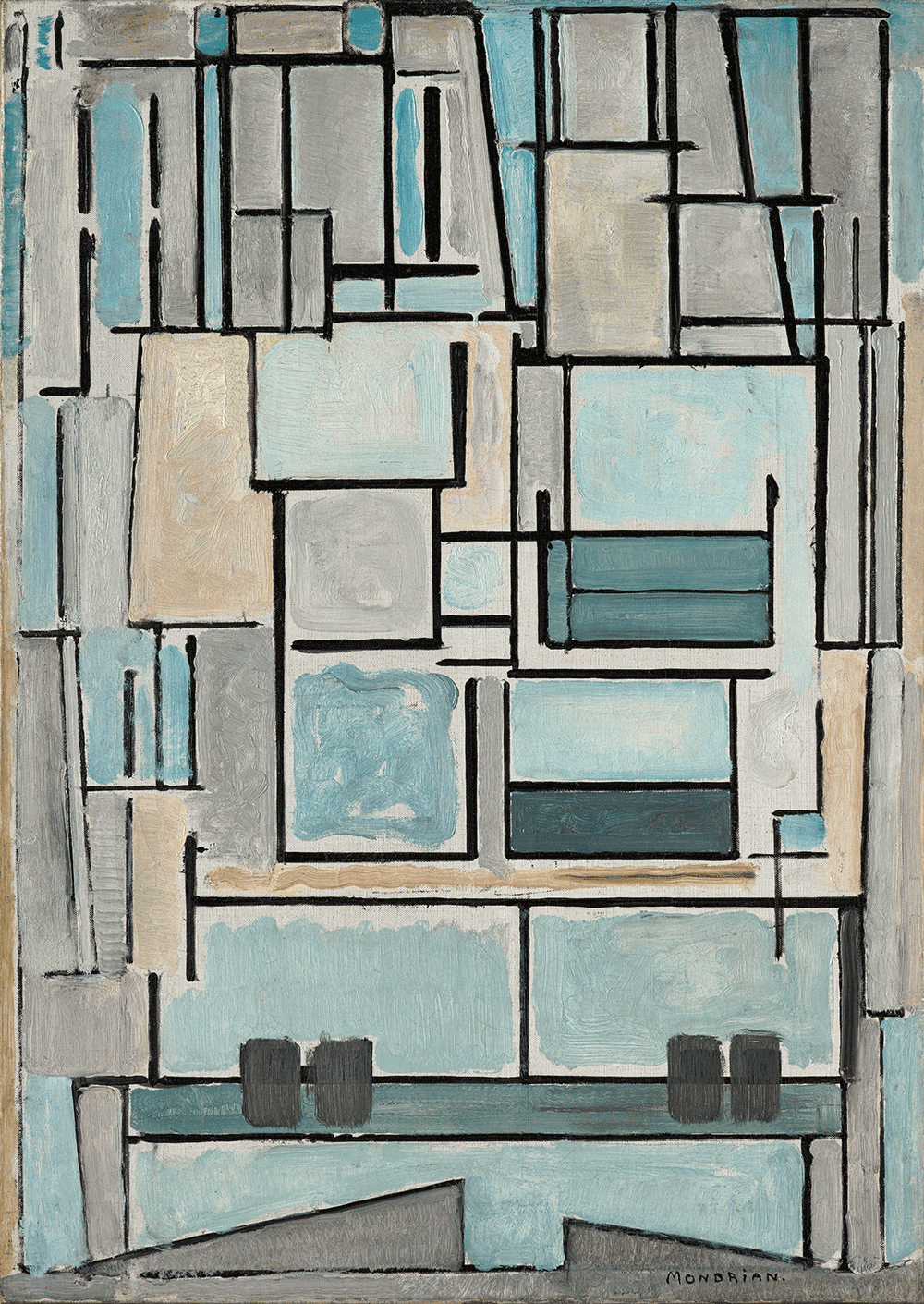 Piet Mondrian. Composition No. VI (Composition 9, Blue Façade), 1914, Oil on canvas, 95,5 x 68,0 cm. Fondation Beyeler, Riehen / Basel, Beyeler Collection © Mondrian / Holtzman Trust
Piet Mondrian. Composition No. VI (Composition 9, Blue Façade), 1914, Oil on canvas, 95,5 x 68,0 cm. Fondation Beyeler, Riehen / Basel, Beyeler Collection © Mondrian / Holtzman Trust
No. VI / Composition No. II
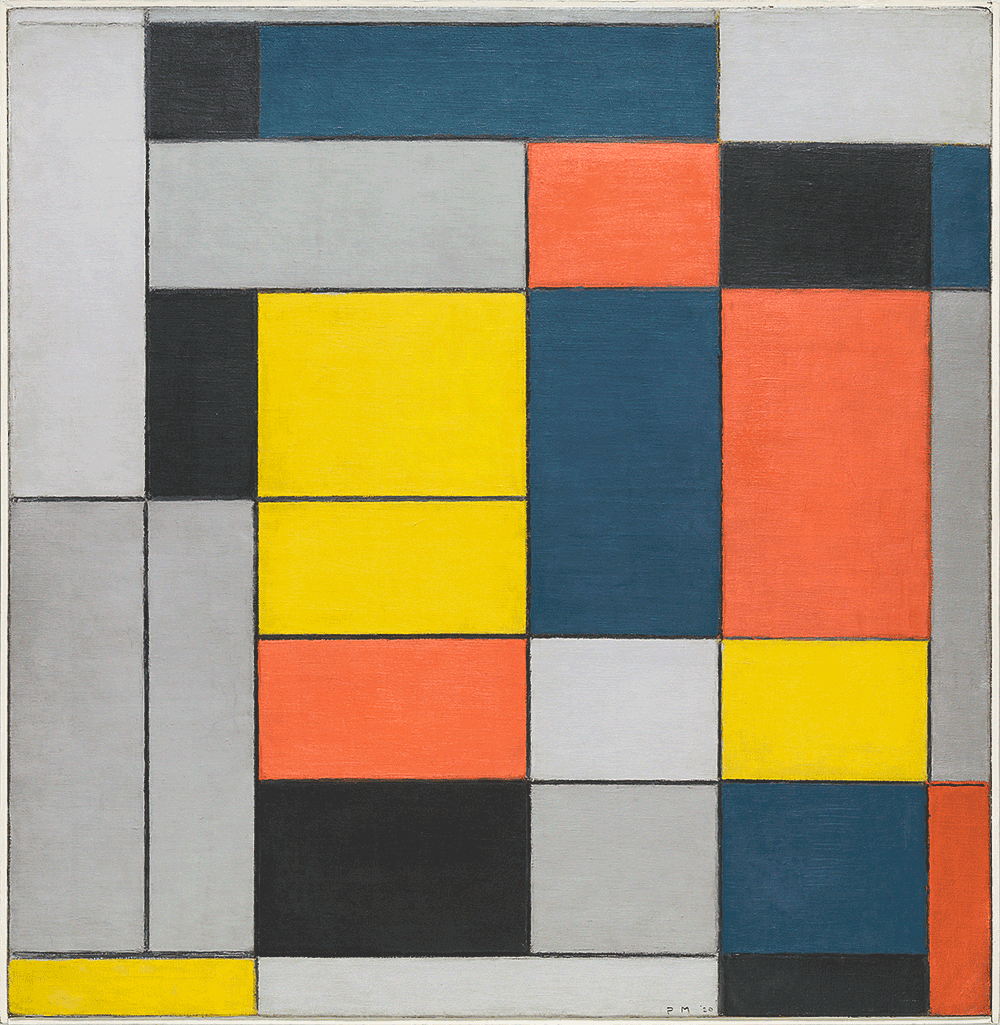 Piet Mondrian. No. VI / Composition No. II, 1920, Oil on canvas, 99.7 x 100.3 cm. Tate, purchased in 1967 © 2021 Mondrian/Holtzman Trust. Photo: Tate
Piet Mondrian. No. VI / Composition No. II, 1920, Oil on canvas, 99.7 x 100.3 cm. Tate, purchased in 1967 © 2021 Mondrian/Holtzman Trust. Photo: Tate
Composition with Yellow and Blue

Piet Mondrian. Composition with Yellow and Blue, 1932, Oil on canvas, 55,5 x 55,5 cm. Fondation Beyeler, Riehen / Basel, Beyeler Collection; acquired with a contribution by Hartmann P. und Cécile Koechlin-Tanner, Riehen © Mondrian / Holtzman Trust c/o HCR International Warrenton, VA USA. Photo: Robert Bayer, Basel
Composition with Double Line and Blue

Piet Mondrian. Composition with Double Line and Blue, 1935, Oil on canvas, 72,5 x 70,0 cm. Fondation Beyeler, Riehen / Basel, Beyeler Collection © Mondrian / Holtzman Trust c/o HCR International Warrenton, VA USA. Photo: Robert Bayer, Basel
Lozenge Composition with Eight Lines and Red
(Picture No. III)
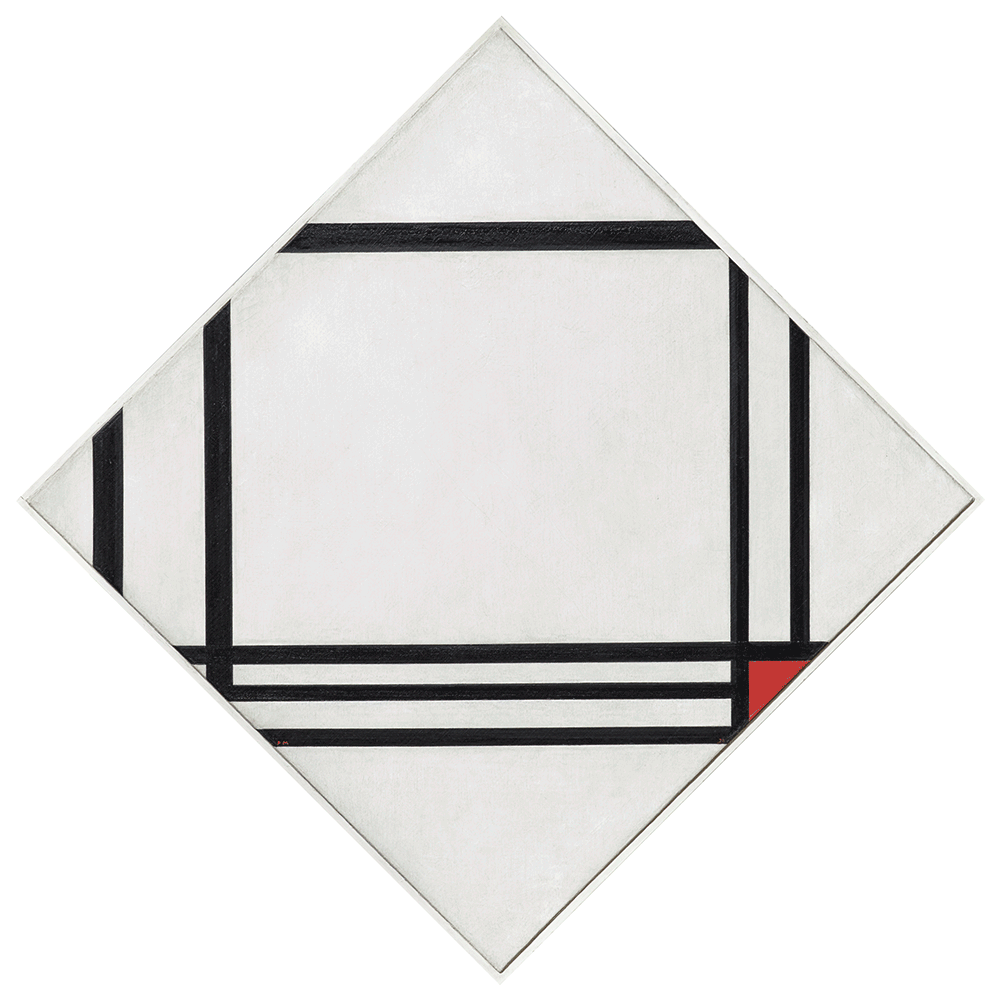 Piet Mondrian. Lozenge Composition with Eight Lines and Red (Picture No. III), 1938, Oil on canvas, 100,5 x 100,5 cm. Fondation Beyeler, Riehen / Basel, Beyeler Collection © Mondrian / Holtzman Trust c/o HCR International Warrenton, VA USA. Photo: Robert Bayer, Basel
Piet Mondrian. Lozenge Composition with Eight Lines and Red (Picture No. III), 1938, Oil on canvas, 100,5 x 100,5 cm. Fondation Beyeler, Riehen / Basel, Beyeler Collection © Mondrian / Holtzman Trust c/o HCR International Warrenton, VA USA. Photo: Robert Bayer, Basel
New York City 1, 1941
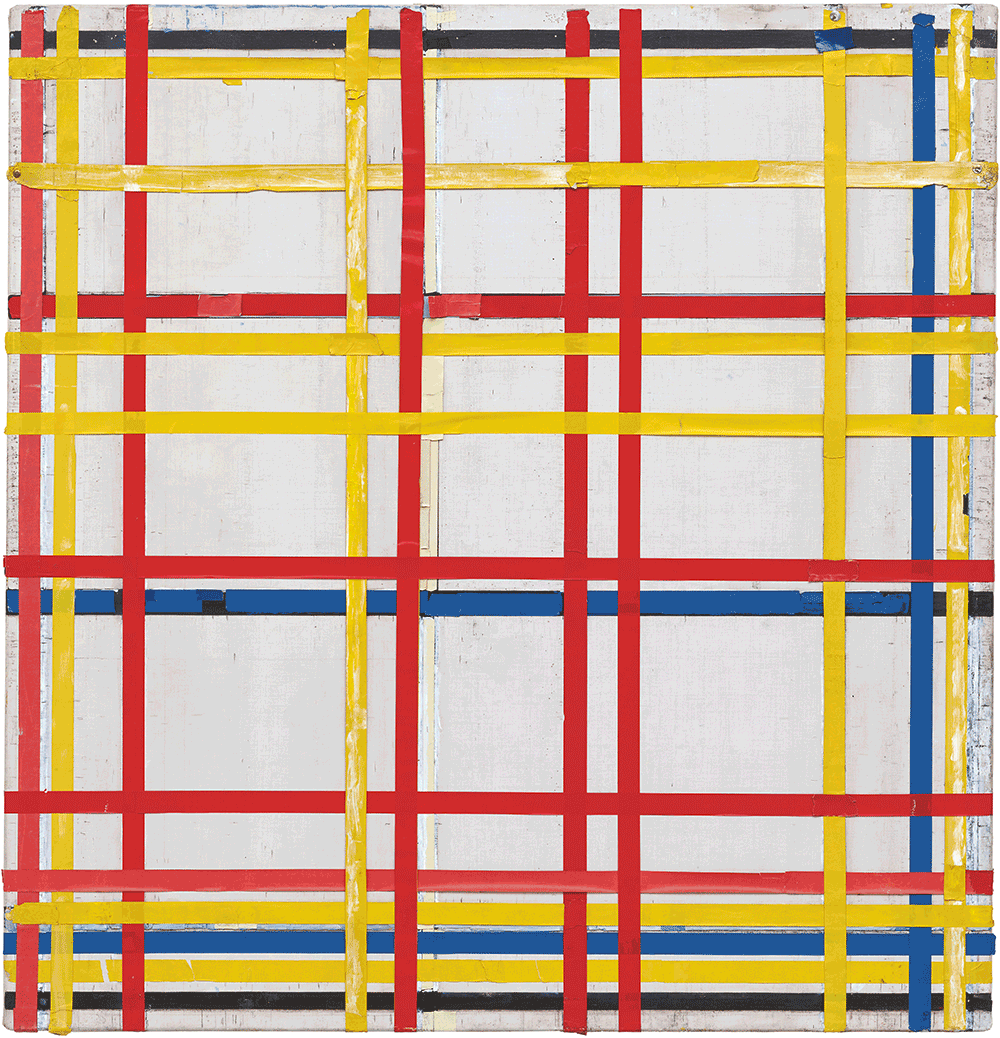
Piet Mondrian. New York City 1, 1941, Oil and paper on canvas, 120 × 115.2 cm. Kunstsammlung Nordrhein-Westfalen, Düsseldorf
HIS LAST YEARS
Mondrian spent the last 25 years of his life in the three cultural centers of the modern era: Paris, London and New York. He lived in Paris from late 1911 to 1938, with an interruption due to the First World War. After a few years in London, in 1940 he moved to New York, where he died in 1944 at the age of 71.
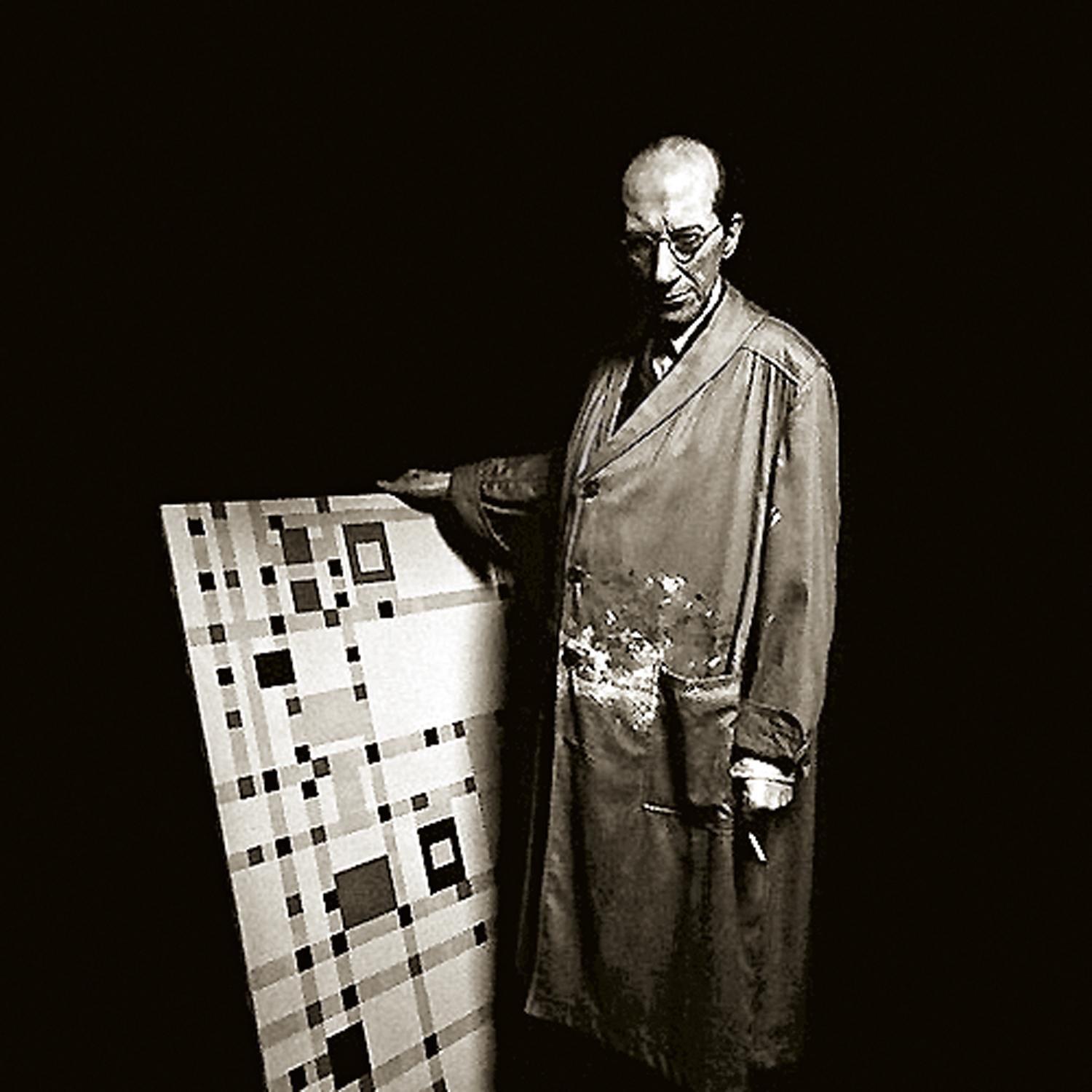
Mondrian in his New York studio with his famous painting Broadway Boogie-Woogie, 1943
MONDRIAN’S THINKING
Mondrian expounded his artistic criteria in theoretical essays. He called his new mode of pictorial expression “Neo-Plasticism”. Mondrian conceived “neoplasticism” as an expression of what is essential in painting: on the one hand, black and white, located at opposite ends of the color scale. And on the other extreme, the primary colors yellow, red and blue. In his painting, as a general rule, black is the color of the lines that run vertically and horizontally, meeting at right angles. The interaction of these elements allows infinite possibilities of pictorial composition. These essential images that Mondrian designed sought a perfect balance and at the same time full of tension, in which all the elements seem to occupy their rightful place.
Mondrian’s art is closely connected to his interest in philosophy and esotericism. Symbolism and Cubism subsequently took on great significance for him.
Mondrian became a celebrity from the 1920s onwards, as an avant-garde artist and co-founder of abstract painting.
Curators: Ulf Küster, Senior Curator, Fondation Beyeler, Kathrin Beßen and Susanne Meyer-Büser, Kunstsammlung Nordrhein-Westfalen.
Sponsors: Beyeler-Stiftung, Hansjörg Wyss, Wyss Foundation, Hilti Art Foundation, L. + Th. La Roche-Stiftung, La Prairie, FX & Natasha de Mallmann, Novartis, Scheidegger-Thommen-Stiftung, Sulger-Stiftung as well as further private patrons who prefer to remain anonymous
MONDRIAN EVOLUTION
The CATALOGUE
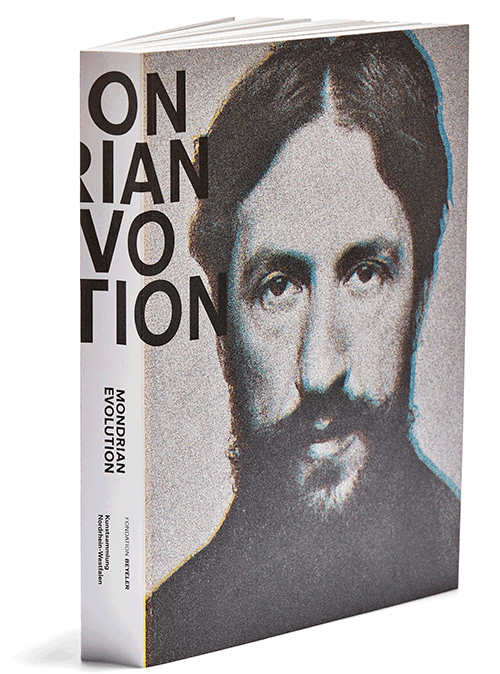
EDITED BY
Ulf Küster für die Fondation Beyeler, Riehen/Basel
TEXTS BY
Benno Tempel, Caro Verbeek,
Ulf Küster, Kathrin Beßen,
Susanne Meyer-Büser,
Charlotte Sarrazin and Bridget Riley
DESIGN BY
Irma Boom
264 pp, 308 ills.
265 x 215 mm
Paperback with Flaps
CHF 58.–, € 54.–
978-3-7757-5236-7 (German)
978-3-7757-5237-4 (English)
Publication date: 13.06.2022
Description
Piet Mondrian had a decisive influence on the development of painting from figuration to abstraction. On the occasion of his 150th birthday, Mondrian Evolution is dedicated to his multifaceted work and artistic development. Initially working in the tradition of late-nineteenth century. Dutch landscape painting, Symbolism and Cubism subsequently took on great significance for him. It was not until the early 1920s that the artist focused on a wholly non-representational pictorial vocabulary, concentrated on the rectangular arrangement of black lines with surfaces in white and the primary colors blue, red, and yellow. In separate chapters, this path is traced through motifs such as windmills, dunes, the sea, farms reflected in the water, and plants in various forms of abstraction.
Biography
PIET MONDRIAN (1872–1944) was one of the pioneers of abstract art. Hailing from a strict Calvinist family, the artist became famous for his compositions of black lines and rectangular fields in primary colors, but his early work was influenced by 19th century Dutch landscape painting.
